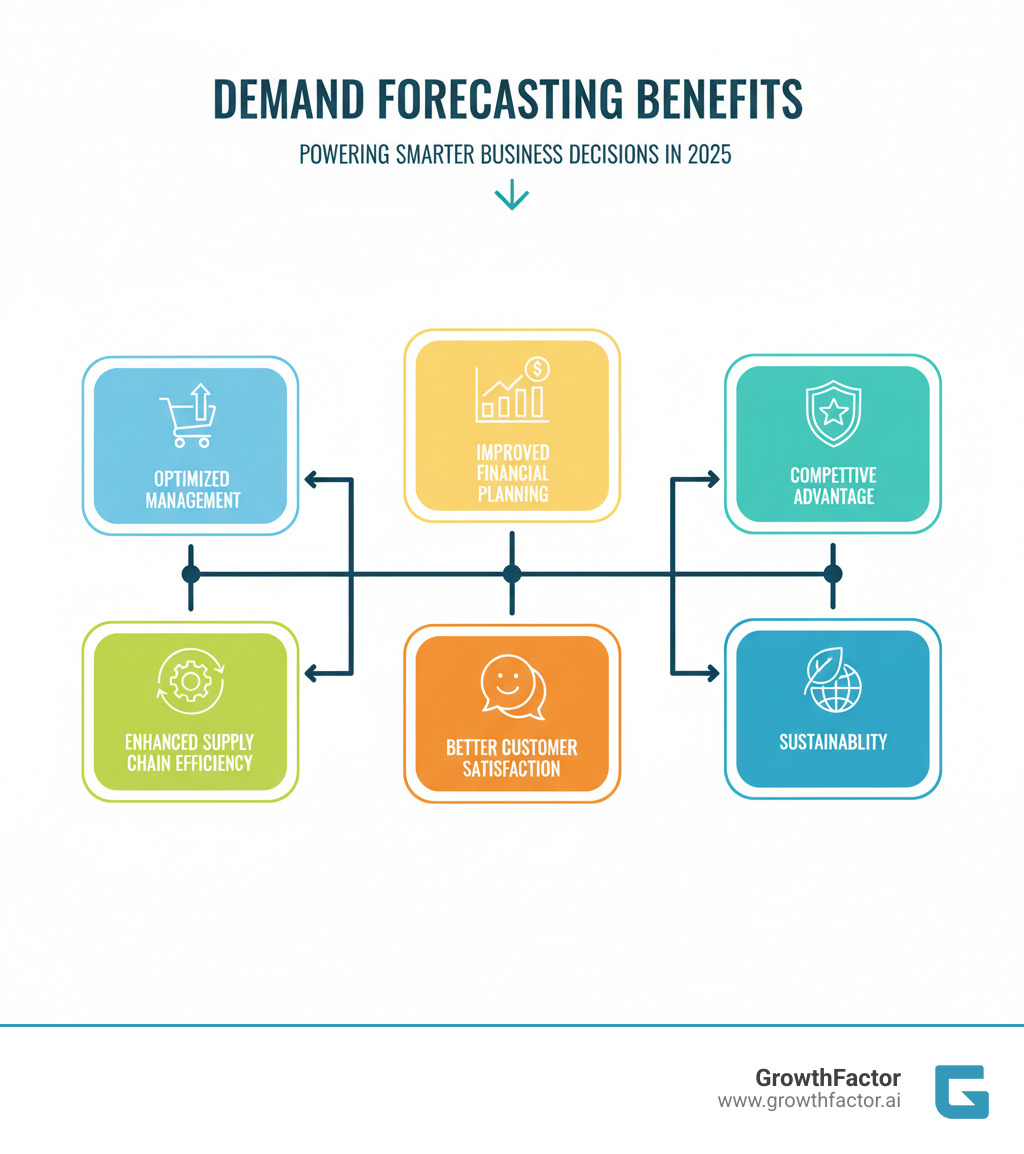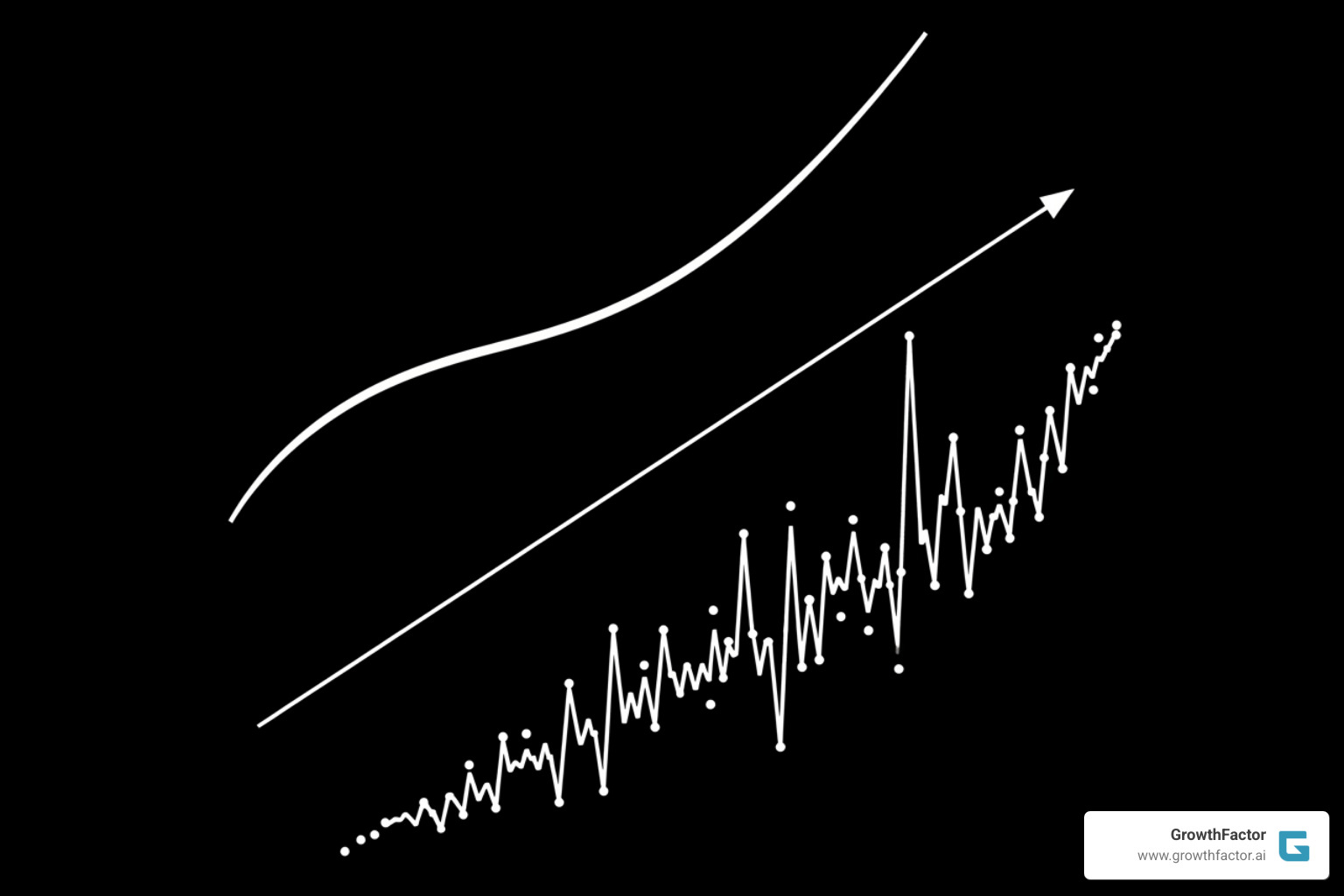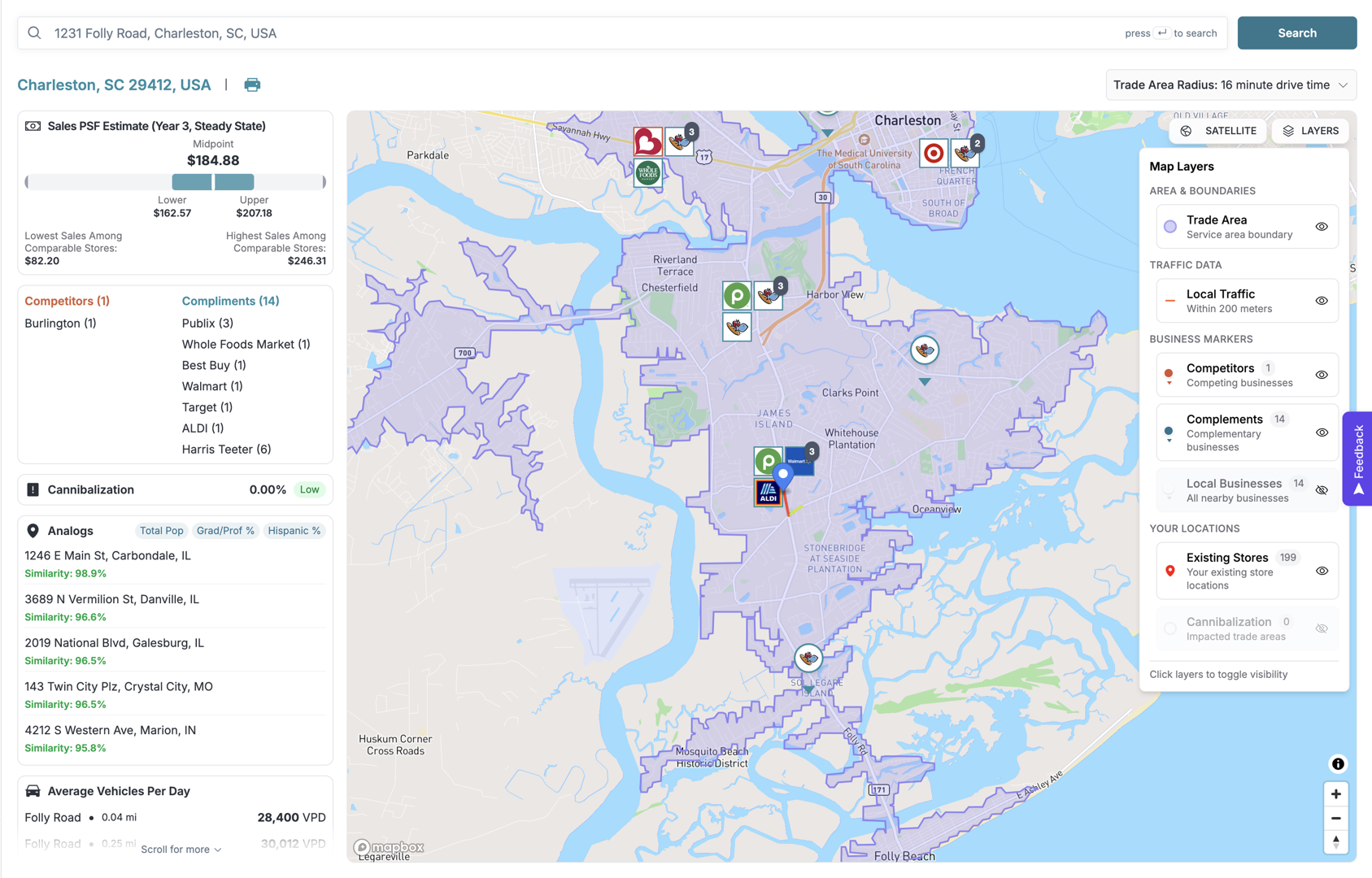From Data to Decisions: How to Forecast Market Demand Effectively
Why Market Demand Forecasting Is Your Competitive Edge

Market demand forecasting is the process of predicting future customer demand using historical data, market trends, and statistical models. It's essential for preventing costly overstocking and understocking, with 79% of businesses with high-performing supply chains achieving above-average revenue growth as a result.
To start, you gather historical sales data, choose a forecasting method, and continuously refine your predictions. Modern approaches using AI and machine learning can process vast datasets to identify patterns humans might miss, leading to more accurate results.
Inaccurate forecasts can lead to grave strategic errors. Conversely, companies like Qantas Airways achieved 94% part availability and released millions in excess inventory through better forecasting. For expanding retail chains, accurate forecasting is the difference between opening successful stores and closing underperforming ones.
With 69% of companies admitting to limited supply chain visibility, many operate with a massive blind spot. This affects everything from inventory levels to meeting peak season demand. For lean real estate teams evaluating hundreds of sites, guesswork isn't an option. The challenge is turning data into trusted decisions, whether you're planning inventory or deciding if a new market can support another location.
I'm Clyde Christian Anderson, founder and CEO of GrowthFactor.ai. With over a decade in retail, from warehouses to real estate analysis, I've seen how critical market demand forecasting is for placing new stores. It's why we built AI-powered tools to help retailers make faster, more accurate location decisions.

Key terms for Market demand forecasting:
The Foundation: Understanding Market Demand Forecasting
Market demand forecasting is about making educated, data-driven predictions about the future to ensure your business thrives. Every decision—from stocking a shelf to opening a new location—is a bet on future demand. The goal is to make that bet based on solid data, not just a gut feeling.
Getting this right delivers several key benefits:
- Optimized Inventory: Avoids tying up capital in overstocked products and prevents lost sales from understocking. For a retailer in Boston or Cambridge, having the right products at the right time is crucial.
- Improved Budget Planning: Enables informed decisions on production, purchasing, marketing, and staffing, ensuring capital is invested for growth.
- Improved Supply Chain Efficiency: Proactive communication with suppliers and streamlined logistics create a supply chain that responds smoothly to actual demand.
- Increased Customer Satisfaction: Accurate forecasts mean products are available when customers want them, turning them into repeat buyers.
For example, Nestle leveraged advanced demand forecasting to reduce inventory by 14-20% while meeting customer demand, saving millions. This is the power of effective Retail Demand Forecasting. For more on this, Market-Xcel offers a great resource in The Essential Guide to Demand Forecasting for Consumer Brands.
Core Forecasting Approaches
Market demand forecasting uses a toolkit of different approaches for different situations.
- Short-term forecasting (under 12 months) is tactical, guiding decisions on seasonal stock, staffing, and production runs to keep daily operations smooth.
- Long-term forecasting (1-5+ years) is strategic, informing capital investments, capacity expansion, and identifying new markets for retail expansion.
- Macro-level forecasting assesses demand across entire economies or industries by analyzing broad indicators like GDP and inflation to understand the overall business climate.
- Micro-level forecasting focuses on specifics, like demand for a single product at a particular store, to optimize individual performance.
- Active forecasting is used for new products or markets with little historical data, relying on market research, surveys, and competitor analysis.
- Passive forecasting is for established products with stable sales, using historical data to predict future patterns.
| Approach Type | Time Horizon | Scope | Primary Use Case | Data Reliance |
|---|---|---|---|---|
| Short-term | Less than 12 months | Specific products/services | Inventory management, staffing, production scheduling | Historical data, real-time sales |
| Long-term | More than 12 months (1-5+ years) | Broad product lines, market segments | Strategic planning, capacity planning, new product development, retail expansion | Macro trends, economic indicators, market research |
| Macro-level | Varies | Entire economy, industry, or large market | Broad economic outlook, industry trends | Economic data (GDP, inflation), market reports |
| Micro-level | Varies | Specific business, product, or customer segment | Individual product sales, local store performance | Granular sales data, customer demographics |
| Active | Varies | New products, new markets, significant changes | New product launches, market entry strategy | Market research, surveys, expert opinion, competitor analysis |
| Passive | Varies | Established products, stable markets | Routine inventory replenishment | Historical sales data, stable trends |
Key Factors That Influence Forecast Accuracy
Accurate market demand forecasting depends on accounting for several key factors:
- Data quality and availability: The principle of "garbage in, garbage out" is absolute. Inaccurate or incomplete data will produce flawed forecasts.
- Seasonality and cyclical patterns: Nearly every product is affected by seasonal trends (holidays, weather) and longer-term economic cycles. Ignoring these guarantees inaccurate predictions.
- Economic conditions: Inflation, employment rates, and consumer confidence directly impact spending. Forecasts must account for these macroeconomic realities.
- Consumer preferences and behavior: Tastes and trends evolve. Relying solely on historical data without monitoring changing consumer sentiment is a risk.
- Competitor actions: A competitor's new product launch, price drop, or marketing campaign can directly impact your demand.
- One-off events: Pandemics, natural disasters, or major promotions create spikes or dips that can distort forecasts if not properly identified and isolated.
The Forecaster's Toolkit: Key Methods and Models
Think of market demand forecasting as assembling a puzzle with different methods and models. The most robust forecasts often come from combining several techniques to create a more accurate picture of the future.

A simple trend line might show the general direction of demand, but a more complex forecast accounts for the regular ups and downs critical for operational planning. Choosing the right method depends on your goal, data availability, and time horizon. The key is matching the method to the question you're trying to answer.
Common Quantitative Methods for Market Demand Forecasting
Quantitative methods use numerical data and statistical analysis, working best when you have solid historical data. They turn numbers into actionable predictions.
- Time-series analysis examines past data to identify patterns like trends, seasonality, and cyclical variations. It's useful for retailers with predictable seasonal swings.
- Moving averages smooth out short-term fluctuations in data to highlight longer-term trends, helping you see the bigger picture.
- Trend projection fits a line or curve to historical data and extends it into the future. It works well when you have a clear, consistent trajectory.
- Regression analysis helps understand the relationship between demand and variables like price, ad spend, or local demographics. This is critical for retail real estate, as explored in our guide on Sales Forecasting Tips for Retail Site Selection.
- Econometric modeling is a sophisticated form of regression that uses economic theories to model complex relationships. FedEx, for example, uses it to forecast package volumes based on economic indicators.
Common Qualitative Methods for Market Demand Forecasting
When historical data is scarce or subjective factors are at play, qualitative methods are essential. They are valuable for new products or market entries.
- The Delphi Method gathers anonymous forecasts from a panel of experts, refining them through iterative feedback to reach a consensus and mitigate individual biases.
- Market research and surveys involve directly asking potential customers about their purchasing intentions, preferences, and price sensitivity.
- Sales force composite taps into the knowledge of your sales teams, who have direct customer interaction and understand local market dynamics.
- Customer focus groups provide in-depth qualitative insights into the "why" behind purchasing decisions through moderated discussions.
As Harvard Business Review notes in Four Steps to Forecast Total Market Demand, the best strategy often combines quantitative and qualitative methods. Quantitative data provides the baseline, while qualitative insights add context and adjust for factors not captured in the numbers.
A Practical 6-Step Guide to Creating Your Forecast
An effective market demand forecast is a systematic process of planning, execution, and refinement. Before starting, be aware of common pitfalls: over-reliance on historical data, lack of cross-departmental collaboration, and treating forecasts as static documents rather than living ones.

Step 1: Define Your Objective
Start by asking: What are we trying to figure out? A clear purpose is essential for making good decisions. Be specific about your goals, whether it's optimizing inventory, planning staffing, or evaluating a new retail location in Cambridge, MA. Your objective will determine the required time horizon (e.g., weekly for inventory, annually for expansion) and level of detail (e.g., SKU, category, or store-level).
Step 2: Gather and Clean Your Data
Your forecast is only as good as your data. This step is critical. Start with internal data sources like historical sales from POS systems, CRM data, and inventory records. Then, incorporate external data sources to understand the bigger picture, including economic indicators, demographic data, and competitor activity. For retail real estate, external data is vital for Data-Driven Site Selection. Finally, perform data governance and cleaning to correct errors, handle missing values, and remove outliers. Clean data leads to trustworthy forecasts.
Step 3 & 4: Select a Method and Analyze the Data
With a clear objective and clean data, choose your forecasting tools. Apply the chosen model that best fits your situation—for example, regression analysis for a new site evaluation or time-series analysis for an established product. When you interpret the results, look beyond the numbers to generate insight. Is there a clear trend? Are there seasonal peaks to plan for? Identify patterns and anomalies by staying curious. For instance, FedEx analyzes macroeconomic data alongside shipment history to predict package volumes, allowing them to spot demand shifts early.
Step 5 & 6: Make Decisions, Then Monitor and Iterate
A forecast's value is realized through action. Translate insights into action by adjusting production, pricing, or marketing strategies based on your predictions. Next, track forecast accuracy using metrics like Mean Absolute Percentage Error (MAPE). This isn't about blame; it's about learning. Create a feedback loop for continuous improvement by comparing forecasts to actual results, analyzing discrepancies, and refining your process. Finally, adjust models over time to reflect that markets, consumer behavior, and your business are constantly evolving. Your forecasting approach must be flexible to remain effective.
The AI Revolution in Forecasting
The landscape of market demand forecasting is being transformed by artificial intelligence. What once took weeks of manual analysis can now be done in minutes with greater accuracy.

Modern retail involves tracking sales, social media sentiment, weather, local events, and countless other variables. For AI, this complexity is a perfect challenge. AI and machine learning can process vast datasets from dozens of sources simultaneously, thriving where traditional methods buckle. More importantly, these systems identify complex, non-linear patterns that human analysts can't see. The biggest game-changer is real-time analytics, which allows forecasts to update continuously as conditions change.
A Gartner survey found that 45% of companies already use machine learning for demand forecasting. This is the new standard. At GrowthFactor, our platform is built on this reality, using AI to help retailers make smarter, faster site selection decisions.
Leveraging AI for Superior Accuracy
AI delivers more than just speed; it enables fundamentally better decisions.
- Predictive analytics for proactive decisions: AI helps anticipate what's coming, allowing you to make strategic moves ahead of the curve, like opening a new location in Cambridge before the market gets crowded.
- Demand sensing for real-time adjustments: These systems monitor immediate signals like website traffic, social media buzz, and search behavior to detect shifts in consumer interest as they happen.
- Personalization at scale: AI can segment markets at a granular level, understanding demand for specific products in specific neighborhoods, which is crucial for site evaluation.
- Automated data wrangling: AI automates the time-consuming process of cleaning and preparing data, freeing up human experts to focus on strategy.
Our guide to AI-Powered Retail Analytics shows how retailers are using these tools to transform their operations.
Emerging Trends in Demand Forecasting
The evolution of market demand forecasting is accelerating.
- Hyper-automation: Entire forecasting workflows, from data collection to model selection, are becoming automated, amplifying the impact of human experts.
- Collaborative forecasting platforms: These tools break down departmental silos, enabling sales, marketing, and operations to build consensus around a unified demand picture.
- Explainable AI (XAI): As models become more complex, XAI aims to make their predictions transparent and interpretable, building trust and allowing for human validation.
- Integration with location intelligence: Combining demand forecasts with geographical data, demographics, and competitor locations is a powerful development. Instead of just knowing demand will increase, you know where it will be strongest. Our Location Intelligence Software guide explores how this is changing retail real estate strategy.
Frequently Asked Questions about Market Demand Forecasting
Here are answers to some of the most common questions we hear from retail teams.
How often should a business update its demand forecast?
The ideal frequency depends on your business rhythm and goals. For operational decisions like inventory management in a fast-moving retail environment, weekly or even daily updates are best. For strategic planning, such as budgeting or evaluating a new location in Cambridge, quarterly reviews with annual deep dives are typical. However, always update your forecast immediately following a significant event, like a major economic shift or a competitor's closure. The key is to create a continuous feedback loop: forecast, compare to actuals, learn, and refine.
What is the most accurate demand forecasting method?
There is no single "best" method. The most accurate approach depends on your data, your goals, and the stability of your market. For established products with rich historical data, quantitative methods like time-series or regression models are effective. For new products or volatile markets, qualitative methods like expert opinions and market research are necessary. Increasingly, the most accurate forecasts come from a hybrid approach, combining the strengths of statistical models, machine learning, and qualitative insights. This is especially true for complex decisions like retail site selection, where dozens of variables are in play.
How can a new business with no historical data create a forecast?
Forecasting without historical data requires a creative, research-based approach. Here are some effective strategies:
- Market research and surveys: Directly ask potential customers about their purchasing intentions and preferences to gather primary data.
- Expert opinions: Use a structured approach like the Delphi Method to gather and refine predictions from industry experts.
- Competitor benchmarking: Analyze the performance of comparable businesses in similar locations to create a proxy dataset. This provides a reasonable starting point for your own projections.
- Pilot programs: Launch in a single, small location (like one store in a Boston neighborhood) to generate real-world sales data. This allows you to test assumptions and refine your forecast before a full-scale rollout.
- Scenario planning: Develop optimistic, pessimistic, and most-likely scenarios to prepare for a range of outcomes and build a more robust plan.
Conclusion
Market demand forecasting has evolved from an analytical exercise into a core business capability that provides a significant competitive advantage. By predicting future customer demand, businesses can optimize everything from inventory and budgeting to strategic growth decisions, like where to open the next retail location. The shift from reactive to predictive decision-making is transformative.
We've covered the foundations, the forecaster's toolkit of quantitative and qualitative methods, and a practical six-step process for creating and refining your predictions. The AI revolution is accelerating this shift, with 45% of companies already using machine learning to process vast datasets and generate real-time insights. For retail real estate, combining market demand forecasting with location intelligence offers a powerful lens for evaluating potential sites, whether in Boston or across the USA.
At GrowthFactor, we've built our platform around these principles. Our AI-powered tools transform complex data into clear, actionable recommendations, helping lean real estate teams make faster, smarter site selection decisions. We replace guesswork with data-driven insights, and anxiety with assurance.
Ready to bring this level of precision to your retail expansion strategy?
Citations
The human algorithm
Request Your demo
Schedule meeting
Or submit your information below and we'll be in touch to schedule.


